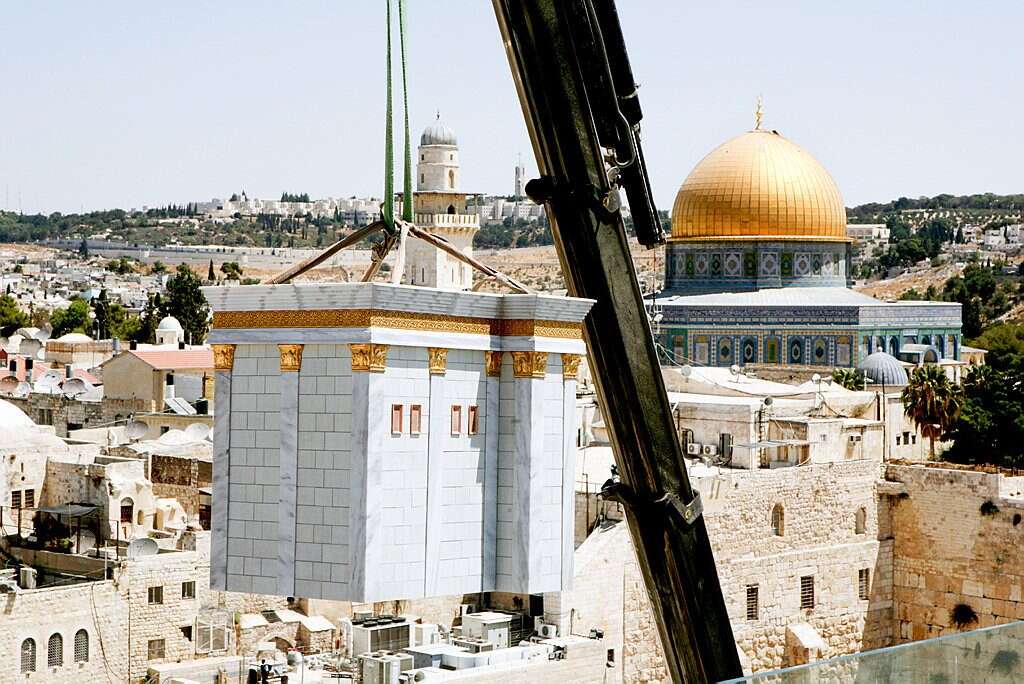James Finn, a British consul in Jerusalem in the 19th century, once described in his diary the Sudanese guards at the Temple Mount compound as people whose very look could arouse fear and even as having murdered Christians who snuck into the compound.
These Sudanese guards were so stealthy that in 1855, the Muslim Waqf put them in jail to ensure that the Belgian Duke of Brabant, a Christian, could visit the Mount safely. The Waqf went so far as to forbid photographers to document the historic visit, during which the "superior religion" (as Islam sees itself) honored someone who represented either Christianity or Judaism.
Follow Israel Hayom on Facebook and Twitter
When the exhibit "The Mount," which is currently open at the Tower of David Museum, was being researched, museum director and curator Eilat Lieber and curator of the exhibit Shimon Lev left no stone unturned to find a photograph of that historic visit and were astonished that none could be found. Although that fit in well with the fact that the first photographs of the Temple Mount, from 1839, were taken from a distance, mostly from the Mount of Olives, by Christian photographers who controlled the newly-invented craft. The work – while lovely – suffers from its distance from the subject.
But only a few years later, the Mount was opened to Christian, Armenian, and even one photographer who had been born Jewish and later converted. Many documented the inner compound and events that took place there. The exhibit "The Mount" offers an exciting photographic glimpse at the modern-day biography of the Jerusalem volcano, its eruptions (which were almost always the result of events that started far away), and many peaceful moments of the last 180 years.
A Jewish visit from Cyprus
In 1898, when non-Muslims were no longer barred from the Temple Mount compound, German Emperor Wilhelm II visited. Photographers from the American Colony in Jerusalem took pictures. Three years later, in 1901, running water was put into Al-Aqsa Mosque. Lev and his research assistant Yael Brandt discovered a rare photograph of the ceremony marking that development in a book called "Al-Quds Album," which was published by a Turkish organization.
"That was the first place in the Old City to be connected to running water," Lev says.
The curators also managed to locate a picture of King Hussein of Jordan switching on the first electric lights at Al-Aqsa. However, it is not included in the exhibit because the rights to it were unclear.
The curators also encountered difficulties in working with the Waqf. After a few conversations, it became clear that the Muslim administrative authority was afraid to work with a public Israeli museum located in the Old City. Nevertheless, the exhibit is full of other photos.
Men and women, un-separated
Close-up photos of the beautiful architecture of the Temple Mount and the mosques are to be expected, but much more exciting are the photos that document the first years of the Israeli-Arab struggle over the Land of Israel. One, from April 1920, shows a marching band from Yorkshire taking part in the Nabi Moussa, which developed into anti-Jewish riots; another shows a British patrol plane flying over the Temple Mount during those same riots. A photo from the time of the Arab Revolt shows two British soldiers guarding one of the Temple Mount gates that had been barricaded with planks of wood and barbed wire while Grand Mufi Haj Amin al-Husseini was hiding inside. A photo taken right after the Jewish Quarter was occupied in the 1948 War of Independence shows King Abdullah I of Jordan visiting Al-Aqsa, accompanied by soldiers from the Jordanian Legion.
The Western Wall also appears in the exhibit. A photo from the time it was under Jordanian control shows it as it appeared then – one side of a narrow side alley.

Another rare photograph by an unknown photographer taken from the air illustrates the difference between the Western Wall today, with its expansive plaza, and the narrow passageway on the edges of a residential area, before Israel demolished those homes in 1967. The Turks allowed Jewish prayer in the passageway only after a major earthquake struck Jerusalem in the 16th century. The quake destroyed some of the homes that were built up against the Western Wall.
Another picture of the "wall passage" from 1880 shows Jewish men and women worshipping side by side.
'The most volatile'
The exhibit also does justice to Amos Zucker, an intelligence officer in the IDF's Southern Command and an amateur photographer. During the 1967 Six-Day War, he found himself with nothing to do, so he attached himself to the Central Command in Jerusalem. According to Lev, Zucker – who is unknown – rather than his more famous colleagues like David Rubinger or Micha Baram, was actually the first to photograph Israeli forces entering the Temple Mount.
The photos of paratroopers walking up the steps to the Dome of the Rock, or of paratroopers raising the Israeli flag on the iron fence on top of the Western Wall, were taken by Zucker. Dozens of his other pictures provide more fodder for historians. These pictures, Lev believes, settle the dispute about "who got there first" – it was the paratroopers, not the Jerusalem Brigade.
Lev and Lieber decided to keep the most difficult images of the ethnonational-religious conflict over the Mount, the ones that show blood and bodies, out of the exhibit. They did include images of violent demonstrations, as well as images that show that the charged location once knew calmer days, such as a photo of Israeli model Aviva Banai taken with the Dome of the Rock in the background as part of a series for the Gottex swimsuit company.
"We aren't here to school anybody," says Lieber.

"We are bringing the modern photographic history of the Mount to the public. This is another aspect of research of [the Mount], but we are careful not to interpret it. We also organize tours of the Temple Mount – thousands have already taken part – with the best guides there are."
Lev, a veteran artist who has curated dozens of exhibits, says that "The Mount" marks the apex of his curatorial career.
"It's the most loaded, sensitive, volatile subject in the Middle East, so it was also the most challenging and meaningful exhibit I've curated so far," he says.




